
The NCWNP District’s Daruma Award honorees (Photo: Cathy Fujimori)
The NCWNP hosts its 2025 gala award banquet
and honors several awardees and unsung heroes of the district.
By Emily Murase, P.C. Contributor
Celebrating the theme of “Art, Advocacy and Activism,” more than 200 JACLers from the Northern California Western Nevada Pacific District convened for the 2025 Gala Award Banquet on April 5, a cloudless day in the beautiful suburb of San Ramon, east of San Francisco.
The NCWNP District is the JACL’s largest regional district, representing more than 3,000 members from 31 chapters. The event, held every two years, featured many unique silent auction items, donated by chapters and members, to shine a light on honorees and raise money for district activities.
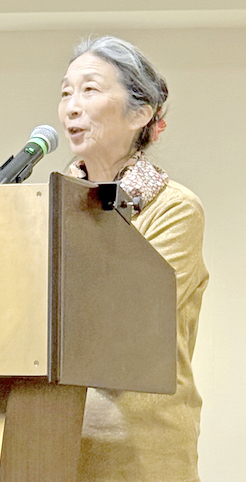
NCWNP District Gov. Carol Kawase welcomed attendees to the 2025 gala luncheon.
Following the Pledge of Allegiance, longtime NCWNP District Gov. Carol Kawase opened the gala with welcoming remarks. The gala was an opportunity to showcase achievements reflected in this year’s event theme, such as the pioneering work of Roy and PJ Hirabayashi, founders of San Jose Taiko, and to acknowledge the extraordinary work of the JACLers receiving awards.
Kawase explained that the Japanese phrase Nana korobi, ya oki, meaning “seven times down, eight up,” embodies the perseverance of the community and serves as the inspiration for the District Daruma Awards. Kawase noted the dedicated efforts of the Gala Committee, including Thaya Mune-Craig, Debbi Endow Hatanaka, Nikki Hikari, Mariko Fujimoto and Kiana Lovgren, who, together, spent a year planning the event.
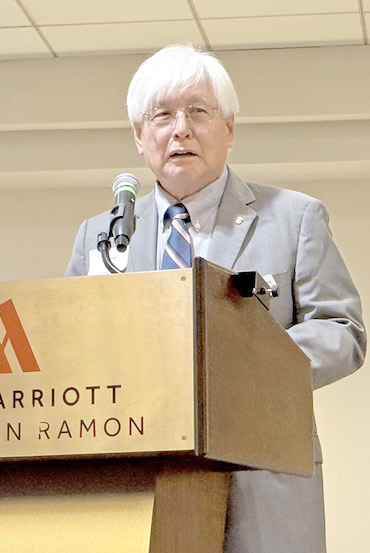
JACL National President Larry Oda offered opening remarks.
(Photos:
Emily Murase)
Emcee Jana Katsuyama, the Emmy award-winning TV journalist for KTVU Fox News, then welcomed JACL National President Larry Oda for brief remarks. Oda invited everyone to mark their calendars for the 100th anniversary of the historic JACL building in Monterey next year, a building that embodies the themes of “advocacy and activism.”
Oda also paid tribute to Nikkei actor-author George Takei for bringing the Japanese American wartime experience to life through the hit Broadway play “Allegiance” and three accomplished women Nikkei artists Miki Hayakawa, Hisako Hibi and Miné Okubo, whose work is showcased at the Smithsonian American Art Museum until Aug. 17.
Next, Consul General of Japan Yo Osumi reported on his office’s new initiatives to strengthen U.S.-Japan relations, including the Nikkei Next Generation Initiative, held in San Francisco Japantown in November 2024. In addition, the Nikkei NextGen Women Leaders convened in San Jose Japantown in March; participants included Mayor of Mountain View, Calif., Ellen Kamei and NCWNP District Secretary Mariko Fujimoto.
Regarding education, Osumi highlighted the continuing success of the Kakehashi Program, which sends Japanese American college students and young professionals on tours of Japan. He also stated that additional educational resources on studying abroad and scholarships are available on the Consulate’s website. Osumi then introduced his staff person, Mayu Hagiwara, consul and director of the Japan Information and Cultural Center.
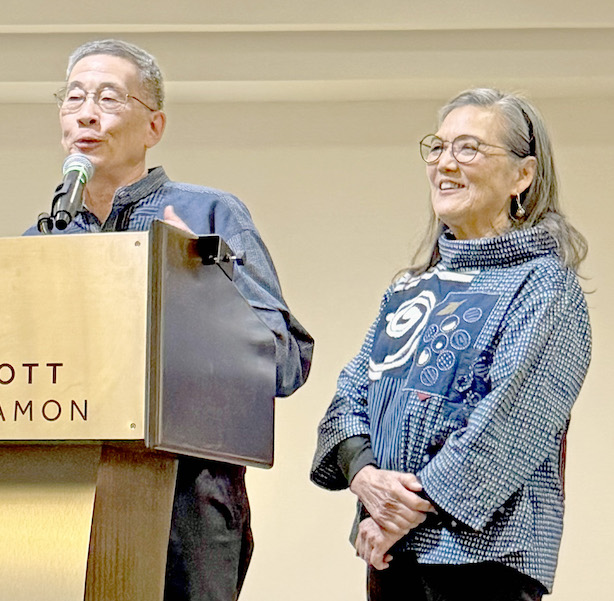
The gala’s keynote speakers were Roy and PJ Hirabayashi, co-founders and artistic directors emeritus of San Jose Taiko, who spoke about their families’ WWII incarceration experience and gave a musical performance.
(Photos: Emily Murase)

Consul General of Japan Yo Osumi
Over lunch, keynote speakers Roy and PJ Hirabayashi, co-founders and artistic directors emeritus of San Jose Taiko, took center stage and presented a slideshow. They shared parts of their Japanese heritage. PJ’s mother, originally from Fukushima, was one of 11 children, while Roy’s grandparents arrived from Hiroshima in the early 1900s. As early immigrants to the U.S., both of their families experienced the wartime incarceration.
PJ and Roy spoke about how the activism among ethnic communities in the 1960s and ’70s, particularly in San Francisco and Berkeley, catalyzed their work. Initially, drumming was just a way of connecting with the Issei generation through music.
They started San Jose Taiko in 1973 with the strong support of Rev. Hiroshi Abiko, then of San Jose Buddhist Church Betsuin, and taiko became a way to define a Japanese American voice. They were inspired by Asians for Community Action, based in San Jose and active from 1970-74, with young leaders such as Chris and Dan Kubo, as well as the duo of singer-songwriters Chris Iijima and vocalist Nobuko Miyamoto, who were powerful community activists.
PJ and Roy explained that the first taiko groups all started on the West Coast: San Francisco Taiko Dojo in 1968, Kinnara Taiko of the Los Angeles-based Senshin Buddhist Temple in 1969 and San Jose Taiko in 1973. The first national conference of taiko groups, now known as North American Taiko Conference, was held in 1997 in Los Angeles.
The conference is held every two years, and its 2011 gathering, held at Stanford University, featured more than 800 attendees. This year’s gathering will be held in Phoenix, Ariz., at the Phoenix Convention Center from Aug. 29-Sept. 1.
After realizing that there was very little change in the repertoire of taiko compositions, PJ composed “Ei ja nai ka/Isn’t It Good,” which has now become a regular feature of Bon Odori festivals throughout Northern and Southern California, Oregon and Hawaii; it is even performed in Japan.
Today, PJ and Roy continue their art activism. In 2008, PJ launched TaikoPeace to promote a peaceful world through taiko drumming. In April, they embarked on a trip to Japan, beginning with a performance at the Japanese Overseas Migration Museum in Yokohama to celebrate the launch of a new exhibit focused on San Jose Japantown and ending with visits to world-famous taiko studios in rural Japan.
HONOREES
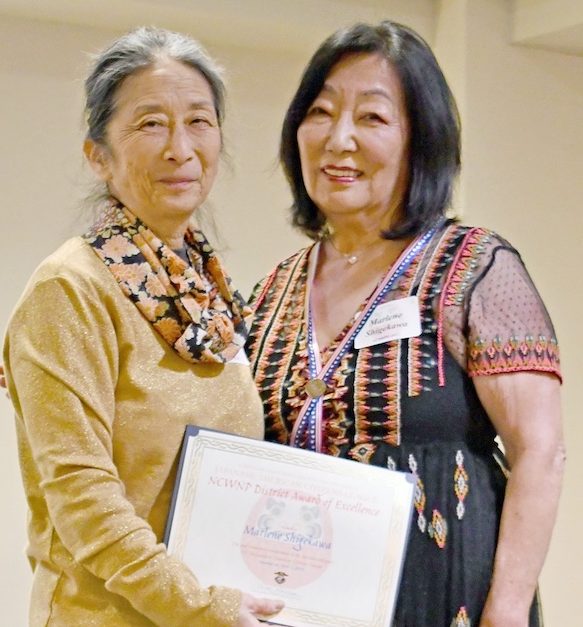
Gov. Carol Kawase (left) with awardee Marlene Shigekawa
(Photo: Cathy Fujimori)
NCWNP Gov. Kawase presented Marlene Shigekawa with the NCWNP Award of Excellence for her landmark work as a writer/director/film producer. Her latest film, “The Blue Jay” (2023), is a 14-minute narrative film inspired by her family’s experience as incarcerees of the Poston, Ariz., concentration camp that is part of an online curriculum for high school and college students.
Her earlier work, “For the Sake of the Children” (2016), is an hourlong documentary focused on the mothers at the Poston concentration camp during WWII. She is also known for her children’s books, including “Blue Jay in the Desert” and “Welcome Home Swallows.”
Shigekawa serves as executive director of the Poston Community Alliance to preserve the legacy of the Poston incarceration experience. In presenting the 2025 Award of Excellence to Shigekawa, Kawase explained that Shigekawa’s work embodies the event’s theme of art, advocacy and activism.
In her acceptance speech, Shigekawa shared her experience screening “The Blue Jay” at Parker High School, a public school not far from the location of the Poston concentration camps. The diverse student audience was composed of many students of color, including Mexican Americans and Native Americans, who felt that the film made their own struggles visible. “What matters is not the number of awards you receive for your work, but that moment when you know you’ve touched a young person,” explained Shigekawa.
Daruma Awards
Next, Kawase presented the 2025 Daruma Awardees, who were recognized as the “unsung heroes” of the district. NCWNP Youth Board Chair Kiana Lovgren presented the District Youth Board Daruma Award.
Carolyn Adams, Berkeley Chapter: A Millenium Club member like her parents, Adams dedicated her career to teaching in Berkeley as one of the earliest Asian American teachers in the district. She is a longtime member of the Berkeley chapter board, contributing to the newsletter and the scholarship program. She also speaks regularly in the community about the Japanese American experience.
Joe Bowes, Watsonville-Santa Cruz Chapter: For more than 40 years, Bowes and his wife, Christine, have been dedicated JACLers. He contributes essential support for the upkeep of the JACL Kizuka Hall and the Japanese Memorial Garden in Salinas. Nicknamed “Taiko Joe,” he has also crafted hundreds of taiko drums from scratch.
Gael Forest-Knowles, Sonoma County Chapter: An inspirational ally, Forest-Knowles partnered with the Sonoma County JACL chapter in 2022 to advocate for the inclusion of Hebrew, Japanese and other languages in a local city monument. She serves on the board of the Congregation Shomrei Torah, which is working actively on immigration protection.
Nick Hori, Silicon Valley Chapter: In 2009, Hori became the chapter’s youngest board member. Over the past 16 years, he has assumed the roles of District and National Convention Delegate, District Youth Representative and a member of the Young Professionals Caucus. Known to have a “great brain,” Hori is also very outgoing and an expert networker with other chapters.
Arleen Mataga, Lodi Chapter (posthumous): Mataga served as chapter secretary for 31 years and regularly attended quarterly district meetings and national conventions as the Lodi Chapter Delegate. She was a perennial volunteer at many Japanese American events and fundraisers, including the Lodi Buddhist Church. Mataga also shared her experiences in the Japanese American community as a docent at the California Museum in Sacramento.
Janet Mitobe, Eden Township Chapter (posthumous): A former chapter president, Mitobe served on the board for more than 40 years, from 1981 until her untimely death in 2023. She worked tirelessly on such landmark projects as the Watkins Street Japanese American Memorial Market (completed in 2021) and the Japanese American Memorial at Hayward Heritage Plaza Park (dedicated in 2023).
Steve Sue, Stockton Chapter: A chapter board member since 2006, Sue has served as president since 2011. He contributes an enormous amount of time, talent and resources to JACL activities, including district meetings and national conventions. A founding executive director of the Asian Repertory Theater, he formerly produced “Our Voice,” a local TV program showcasing Asian Americans in the Stockton area.
Deanna Tsukamoto, Florin Sacramento Valley Chapter: Tsukamoto poured her energy, enthusiasm and organizational skills into revitalizing the Women’s Forum to focus on Japanese cultural activities such as the tea ceremony and the art of wrapping with furoshiki. Today, the Women’s Forum has become one of the chapter’s most successful activities, thanks to Tsukamoto’s vision and dedication.
Halle Sousa, District Youth Board: Sousa has worked behind the scenes to expand youth engagement at the district and national levels for several years. She implemented an $11,000 grant to enhance youth members from the district to the JACL National Convention and currently serves as the district representative to the National Youth/Student Council. Sousa is also vice chair of the NCWNP District Youth Board.
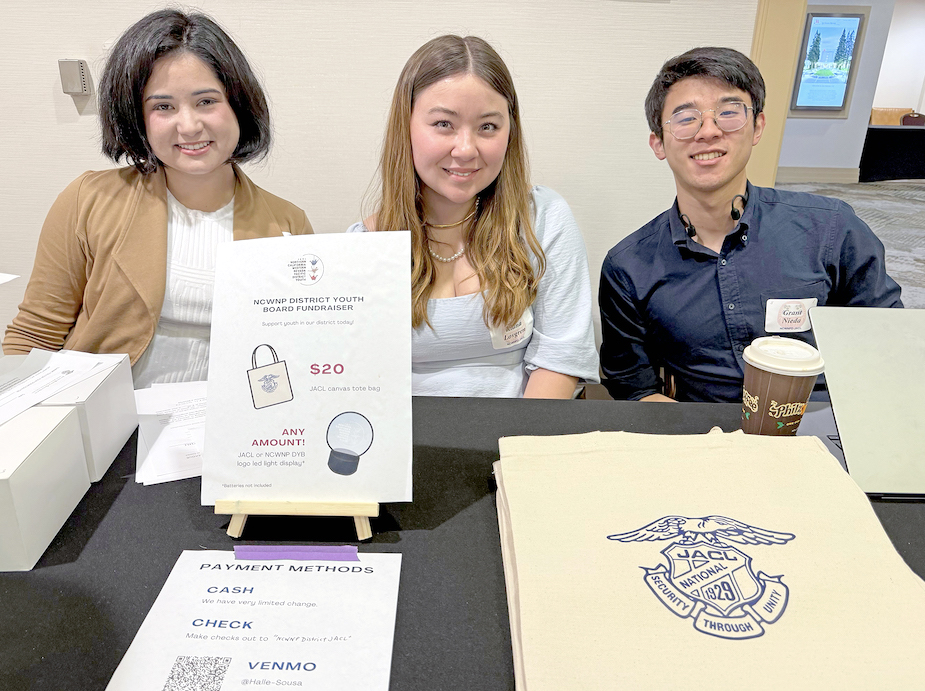
Pictured at the NCWNP Youth Board Fundraiser are (from left) Halle Sousa (San Jose chapter), Kiana Lovgren (Berkeley chapter) and Grant Nieda (Silicon Valley chapter).
Finally, JACL Awards were presented to four stalwart JACL district leaders who represent 120-plus years of combined service to their chapters and the NCWNP District. Marcia Hashimoto of the Watsonville-Santa Cruz chapter received the Silver Pin for exemplary service to her chapter. Debbi Hatanaka, Lily Kawafuchi and Mark Kobayashi each received the Sapphire Pin for their many years of service to the district and national levels.
This article was made possible by the Harry K. Honda Memorial Journalism Fund, which was established by JACL Redress Strategist Grant Ujifusa. To make a donation to this fund, email busmgr@pacificcitizen.org and put Honda Memorial Journalism Fund in the subject line.



